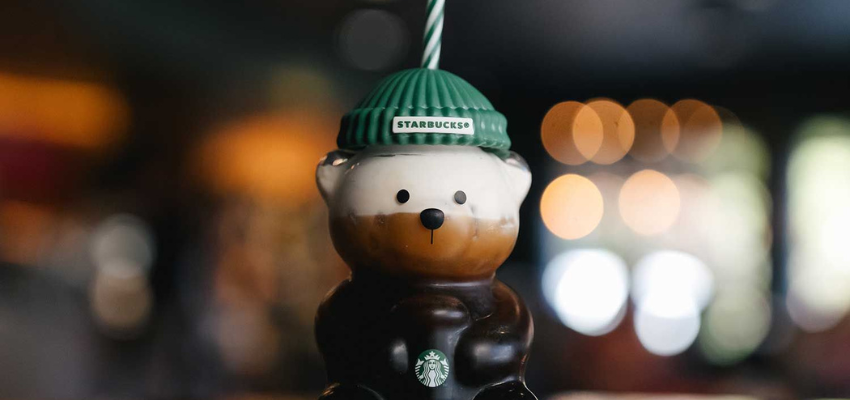When Starbucks released its Bearista Cup on November 6, 2025, a 20-ounce glass tumbler shaped like a teddy bear wearing the brand’s signature green hat, it wasn’t meant to break the internet. Priced at $29.95, the starbucks bear cup became a viral sensation, selling out within hours, fetching resale prices of up to $325, and generating thousands of listings online . From ABC News to CBS News, the story became headline news as consumers lined up overnight and social media feeds filled with #BearistaCup videos.
The frenzy around a simple glass bear cup reveals more than just seasonal hype. It offers a window into how scarcity, emotional design, and collectible culture drive modern consumer behavior and how foodservice brands can harness those same levers to create loyalty and incremental revenue.
At a Glance
The Starbucks Bearista Cup: when a drinkware becomes desire
The Starbucks Bearista Cup started as a limited-edition holiday item but quickly turned into a symbol of consumer obsession. Stores received only one or two units per location, creating instant scarcity. Customers camped outside, and some store employees reportedly bought the cups before customers could (Business Insider, 2025). On TikTok and Reddit, users shared their disappointment or triumph, turning each purchase into a mini social event.
Within days, the Bearista Cup sold out nationwide and appeared in resale listings: prices soared from $29.95 to more than $300 per cup, a markup of over 800%. The demand was so intense that Starbucks released a statement promising more merchandise soon (E! News, 2025).
The Bearista Cup was more than a novelty. It became a case study in emotional branding: the ability to create a sense of joy, nostalgia, and exclusivity that transforms an ordinary product into a cultural artifact.
The Labubu Phenomenon
Long before the Bearista Cup went viral, Pop Mart’s Labubu had mastered the art of scarcity and emotional design. The mischievous creature, with sharp teeth and oversized ears, epitomizes the “ugly-cute” aesthetic that dominates collectible culture.
Each figurine is sold in a blind box, meaning buyers don’t know which version they’ll get until they open it.
This surprise mechanic fuels repeat purchases and emotional connection. Labubu figures can sell for hundreds or even thousands of dollars on the resale market. A life-sized Labubu doll once sold for $150,000 at a Beijing auction (China Briefing, 2025). Pop Mart’s Labubu line generated $418 million in revenue in 2024 — a 726% year-on-year growth (Market Decipher, 2025).
Like Starbucks, Pop Mart turns products into emotional tokens. Both brands leverage design, scarcity, and storytelling to generate loyalty and cultural relevance far beyond their core product.

Shared success factors: the viral logic of collectibles
1. Strategic Scarcity
Starbucks accidentally created scarcity by under-supplying stores, Pop Mart does it deliberately through limited drops. Either way, scarcity fuels FOMO (fear of missing out) and amplifies desire. For foodservice brands, scarcity should be planned and communicated, not accidental.
2. Emotional Design
The Bearista Cup and Labubu share one trait: instant emotional appeal. Whether cute or quirky, both evoke joy. Emotional design drives attachment, and attachment drives repeat purchase.
3. Surprise Mechanics
Pop Mart’s blind boxes keep buyers engaged through unpredictability. Starbucks achieved a similar effect unintentionally: customers didn’t know which stores would restock or when. Foodservice operators can replicate this excitement through seasonal variations or mystery drops.
4. Secondary Market Validation
When consumers resell a $30 cup for $300, the resale market becomes part of the marketing story. Secondary market buzz validates desirability and amplifies cultural impact.
5. Influencer & UGC Amplification
Labubu was boosted by celebrity fans like Lisa from BLACKPINK and Kim Kardashian. The Bearista Cup went viral through user-generated content on TikTok and Reddit. In the age of authenticity, micro-influencers and passionate fans often outperform paid campaigns.
6. Omnichannel Distribution
Pop Mart’s collectibles sell in stores and online through TikTok Shop, driving global demand. Starbucks’ strength lies in its physical presence, but its next opportunity is e-commerce and digital exclusives to extend reach.
7. Narrative Continuity
Pop Mart sustains engagement through regular restocks and collaborations (One Piece, Coca-Cola). Starbucks’ single drop created temporary hype but missed an opportunity for follow-up releases. Ongoing storytelling is key to sustaining momentum.
Common Mistakes to Avoid
1. Underestimating demand
Starbucks severely underestimated demand, sending only one or two units to stores serving thousands of daily customers. For limited editions, plan for 5–10% of your audience to want one
2. Poor control of resale and employee access
Some Starbucks employees reportedly bought cups before opening hours, creating backlash on social media (Reddit, 2025). Clear internal policies (limit one per customer, enforce sales timing) can prevent reputational damage.
3. Lack of clear restock communication
When Starbucks teased “more merchandise coming soon” without details, it fueled speculation and frustration (E! News, 2025). Transparency is key: announce restocks, manage expectations, and use anticipation as a strategic tool, not an accident.
Three takeaways for foodservice operators
1. Merchandise as a Revenue Stream
The Starbucks teddy bear cup proves that branded merchandise is no longer a side business. Starbucks has built brand equity through limited-edition tumblers for years, but the Bearista Cup turned a $30 collectible into a multi-channel phenomenon. Foodservice operators can design limited-edition, high-emotion merchandise that boosts both sales and social engagement.
2. Emotional Over Functional Branding
Consumers don’t just buy coffee; they buy identity. The Bearista Cup’s charm lies not in utility but in meaning: it represents belonging. In an era of aesthetic consumption, design and emotion outweigh functionality. Brands should build emotional connections through storytelling, sensory design, and shareable moments.
3. Controlled Scarcity & Clear Communication
Scarcity works best when intentional. Both Starbucks and Pop Mart show how limited drops spark engagement, but one did it by accident, the other by design. The lesson: balance exclusivity with transparency. Use scarcity to build anticipation, not frustration. Announce limited runs, communicate restocks, and transform each drop into a community experience rather than a one-day frenzy.
Foodservice trends
















